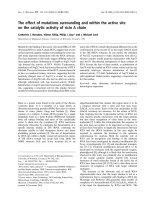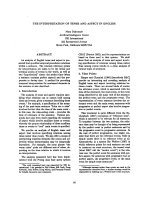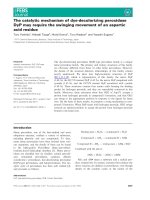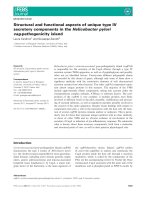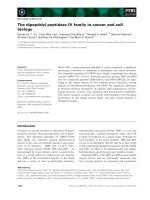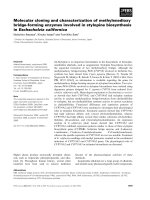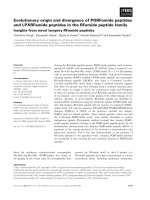Báo cáo khoa học: The catalytic significance of the proposed active site residues in Plasmodium falciparum histoaspartic protease ppt
Bạn đang xem bản rút gọn của tài liệu. Xem và tải ngay bản đầy đủ của tài liệu tại đây (451.35 KB, 10 trang )
The catalytic significance of the proposed active site
residues in Plasmodium falciparum histoaspartic protease
Charity L. Parr
1
, Takuji Tanaka
2
, Huogen Xiao
1
and Rickey Y. Yada
1
1 Department of Food Science, University of Guelph, Canada
2 Department of Food and Bioproduct Sciences, University of Saskatchewan, Saskatoon, Canada
The aspartic proteases, termed plasmepsins (PMs),
produced by the Plasmodium parasite are currently
considered attractive targets for new antimalarial drugs
given their involvement in hemoglobin degradation
[1,2]. The Plasmodium falciparum parasite is known to
encode 10 PMs, PMI, -II, -IV–X and histoaspartic
protease (HAP) [3], four of which (PMI, PMII, PMIV
and HAP) reside within the food vacuole and are
involved in human hemoglobin degradation [4]. PMI,
-II and -IV are considered ‘classic’ aspartic proteases
retaining a catalytic dyad of two aspartic acid residues.
HAP, however, does not share this characteristic.
Although HAP shares $ 60% sequence identity with
PMI, -II and -IV, it is characterized by several substi-
tutions to residues generally conserved in aspartic pro-
teases [5]. Most notable, the active site Asp34 residue
is replaced by His, which eliminates an aspartic acid
residue involved in substrate cleavage. In addition, the
normally conserved Tyr77 and Val ⁄ Gly78 residues are
replaced by Ser and Lys, respectively, in the flap
Keywords
active site; histoaspartic protease; malaria;
model; plasmepsin
Correspondence
R. Y. Yada, Department of Food Science,
University of Guelph, Guelph, Ontario,
Canada, N1G 2W1
Fax: +1 519 824 6631
Tel: +1 519 842 4120; ext 58915
E-mail:
(Received 16 October 2007, revised 9
January 2008, accepted 7 February 2008)
doi:10.1111/j.1742-4658.2008.06325.x
Alanine mutations of the proposed catalytically essential residues in his-
toaspartic protease (HAP) (H34A, S37A and D214A) were generated to
investigate whether: (a) HAP is a serine protease with a catalytic triad of
His34, Ser37 and Asp214 [Andreeva N, Bogdanovich P, Kashparov I,
Popov M & Stengach M (2004) Proteins 55, 705–710]; or (b) HAP is a
novel protease with Asp214 acting as both the acid and the base during
substrate catalysis with His34 providing critical stabilization [Bjelic S &
Aqvist J (2004) Biochemistry 43, 14521–14528]. Our results indicated that
recombinant wild-type HAP, S37A and H34A were capable of autoactiva-
tion, whereas D214A was not. The inability of D214A to autoactivate
highlighted the importance of Asp214 for catalysis. H34A and S37A
mutants hydrolyzed synthetic substrate indicating that neither His34 nor
Ser37 was essential for substrate catalysis. Both mutants did, however,
have reduced catalytic efficiency (P £ 0.05) compared with wild-type HAP,
which was attributed to the stabilizing role of His34 and Ser37 during
catalysis. The mature forms of wild-type HAP, H34A and S37A all exhib-
ited high activity over a broad pH range of 5.0–8.5 with maximum activity
occurring between pH 7.5 and 8.0. Inhibition studies indicated that wild-
type HAP, H34A and S37A were strongly inhibited by the serine protease
inhibitor phenylmethanesulfonyl fluoride, but only weakly inhibited by pep-
statin A. The data, in concert with molecular modeling, suggest a novel
mode of catalysis with a single aspartic acid residue performing both the
acid and base roles.
Abbreviations
2837b, internally quenched fluorescent synthetic peptide substrate EDANS-CO-CH
2
-CH
2
-CO-Ala-Leu-Glu-Arg-Met-Phe-Leu-ser-Phe-Pro-Dap-
(DABCYL)-OH; EK, enterokinase; HAP, histoaspartic protease; PM, plasmepsin.
1698 FEBS Journal 275 (2008) 1698–1707 ª 2008 The Authors Journal compilation ª 2008 FEBS
region of HAP [5]. Tyr77 is conserved in all known
pepsin-like aspartic proteases and plays a key role in
substrate positioning for substrate cleavage [6].
Although HAP contains the alterations of Asp34 to
His and Tyr77 to Ser, it is still functional indicating
that hydrolysis of substrate by HAP must function by
an alternative mode of action [5]. Resolution of a crys-
tal structure for HAP would provide considerable
insight into the unique functionality of this enzyme.
However, no such structure has been reported to date.
In the absence of a crystal structure, molecular model-
ing has been used to propose possible modes of action
for HAP [7,8]. Using homology modeling and molecu-
lar dynamics simulations, it has been suggested that
HAP may be a serine protease with a catalytic triad of
Ser37–His34–Asp214 and an oxyanion hole formed by
Ser38 and Asn39 [8]. Alternatively, it has been pro-
posed that HAP functions through the direct participa-
tion of only Asp214, with His34 providing critical
stabilization to the reaction [7]. In this report, we
describe the biochemical characterization, supported
by molecular modeling, of three mutant HAP proteins,
H34A, S37A and D214A, in an effort to identify the
importance of residues proposed to be catalytically
essential in HAP.
Results
Autoactivation of histoaspartic protease
The H34A, S37A and D214A mutants were investi-
gated to determine the importance of proposed catalyt-
ically essential residues in HAP. The mutations were
chosen based on the proposed mechanisms of action,
which suggested that HAP was either a serine protease
with a catalytic triad of His34, Ser37 and Asp214 [8],
or a novel protease with Asp214 acting alone in sub-
strate catalysis [7]. Alanine was chosen as the substitu-
tion residue because it eliminates the side chain
beyond the b-carbon without imposing any major
structural deviations through electrostatic or steric
effects [9].
The H34A, S37A and D214A mutants were success-
fully introduced into the truncated HAP gene sequence
using site-directed mutagenesis. Wild-type HAP and all
mutants were expressed in Rosetta Gami Escherichia
coli cells. The recombinant wild-type HAP and
mutants were partially purified using nickel-affinity
and gel-filtration chromatography. At this stage, sam-
ples contained predominately fusion protein and a
small amount of zymogen protein as determined using
N-terminal sequencing. After initial purification
samples were tested for autoactivation. SDS ⁄ PAGE
analysis revealed that wild-type HAP, H34A and S37A
were processed to their expected mature size of 37 kDa
[4] in the pH range 5.5–8.0, whereas D214A did not
autoactivate (Fig. 1A).
The complete activation of fusion wild-type HAP,
H34A and S37A protein (confirmed by N-terminal
sequencing), as indicated by band-shift, i.e. 62 to
37 kDa, was a relatively slow process, taking 48 h
(Fig. 1B). The final cleavage between Lys119p (p
denotes prosegment) and Ser120p, confirmed by
Edman sequencing (data not shown), yielded the
mature enzyme. Activity was assessed during autoacti-
vation to ensure that the observed band-shift during
activation was related to activity. Activity levels during
A
a
kDa
117
85
f
z
m
f
z
m
48
34
26
kDa
0 h 1 h 4.5 h 17 h 24 h 48 h
118
90
48
36
27
bc d e
B
Fig. 1. HAP autoactivation. (A) Coomassie Brilliant Blue-stained
15% SDS ⁄ PAGE gel demonstrating processing of wild-type HAP
(lane a), H34A (lane b) and S37A (lane c) after incubation at 37 °C
for 48 h at pH 7.0. D214A (lane d) did not exhibit any processing at
37 °C after 48 h. The preincubated sample is shown in lane e. (B)
Coomassie Brilliant Blue-stained 15% SDS ⁄ PAGE gel demonstrat-
ing the progress of autoactivation of wild-type HAP over 48 h.
Fusion protein (10 lg) was incubated at 37 °C in pH 7.0 for 0, 1,
4.5, 17, 24 and 48 h. f, fusion protein; m, mature protein; z, zymo-
gen.
C. L. Parr et al. Catalytic residues in histoaspartic protease
FEBS Journal 275 (2008) 1698–1707 ª 2008 The Authors Journal compilation ª 2008 FEBS 1699
activation increased with maximal activity being
observed at 48 h. Incubation beyond 48 h, under auto-
activation conditions, resulted in a loss of activity
(Fig. 2).
To test whether improper folding of D214A was
responsible for its inability to autoactivate, D214A
was incubated in the presence of PMII, which has been
shown to process wild-type HAP to a mature size
(37 kDa) (H. Xiao, unpublished results). Upon incuba-
tion at 37 °C for 8 h (HAP to PMII ratio of 50 : 1)
wild-type HAP was processed to its expected mature
size. Similar results were observed for D214A indicat-
ing that the D214A precursor was correctly folded in
order for processing by PMII to occur [10]. However,
further characterization of the D214A mutant was not
conducted because of difficulties in removing PMII
from the activation sample. Removal of PMII from
the sample, despite being added in a relatively small
quantity, was critical because of its ability to more
effectively cleave the synthetic substrate than HAP
[11,12].
pH of maximal activity, kinetic studies and
inhibition
To investigate activity characteristics, protein was acti-
vated in the presence of enterokinase (EK) (for thiore-
doxin tag removal) consistent with the methodology of
Xiao et al. [12]. Samples autoactivated in the absence
of EK also produced comparable kinetic data (data
not shown). The pH profiles of activity for wild-type
HAP, H34A and S37A were determined over the pH
range 3.5–9.5 using the internally quenched fluorescent
synthetic peptide substrate EDANS-CO-CH
2
-CH
2
-
CO-Ala-Leu-Glu-Arg-Met-Phe-Leu-ser-Phe-Pro-Dap-
(DABCYL)-OH (2837b), as previously described by
Istvan and Goldberg [11]. High levels of activity were
observed over a broad pH range (5.0–8.0) with maxi-
mal activity between pH 7.5 and 8.0 (Fig. 3).
Kinetic parameters for wild-type HAP, H34A and
S37A were determined at pH 7.5 using 2837b. Analysis
using the Michaelis–Menten model (Fig. 4) is sum-
marized in Table 1. K
m
values of 3.42 ± 0.81,
2.40 ± 1.06 and 3.44 ± 1.00 lm for wild-type HAP,
H34A and S37A, respectively, were not significantly
different (P > 0.05). The measured k
cat
value for wild-
type HAP (3.15 · 10
)3
± 2.3 · 10
)4
Æs
)1
) was similar
to that previously reported for recombinant HAP [12]
and was higher (P £ 0.05) than that measured for
H34A (9.03 · 10
)4
± 1.45 · 10
)4
Æs
)1
) and S37A
(8.04 · 10
)4
± 7.6 · 10
)5
Æs
)1
).
Inhibition of wild-type HAP, H34A, S37A by phen-
ylmethanesulfonyl fluoride is shown in Fig. 5A. All
forms of HAP were inhibited by phenylmethanesulfo-
nyl fluoride in a dose-dependent manner. Complete
inhibition of all forms of HAP was achieved at 1 mm
phenylmethanesulfonyl fluoride (data not shown).
Interestingly, all forms of HAP were only weakly
inhibited by pepstatin A (Fig. 5B). Wild-type HAP
and S37A were completely inhibited at 150 lm pepsta-
tin A (data not shown), whereas H34A did not exhibit
complete inhibition in the concentration range tested.
Secondary structure determination
The far-UV CD spectra of mature wild-type HAP,
H34A and S37A were determined at pH 6.5 and 8.5.
Fig. 2. Relative activity measured over the course of autoactiva-
tion. Synthetic substrate 2837b was used to assay activity by acti-
vation sample (50 n
M), in 100 mM sodium acetate (pH 6.5). Each
data point represents the mean of two replicates with three deter-
minations each and standard deviation.
Fig. 3. Determination of pH optimum. Effect of pH on wild-type
HAP (
), H34A (d) and S37A (h) activity in 100 mM sodium ace-
tate (pH 3.0–6.5), 100 m
M Tris ⁄ HCl (pH 7.0–8.5) and 100 mM
sodium carbonate (pH 9.0–9.5). Assays were conducted with
50 n
M enzyme and 4 lM peptide substrate 2835b. Each data point
represents the mean of three determinations and standard devia-
tion.
Catalytic residues in histoaspartic protease C. L. Parr et al.
1700 FEBS Journal 275 (2008) 1698–1707 ª 2008 The Authors Journal compilation ª 2008 FEBS
The overall far-UV CD spectra for wild-type HAP,
H34A and S37A were similar. This observation was
reflected in the predicted secondary structures
(Table 2), which were not significantly different
(P > 0.05) and indicated that HAP consists of $ 10%
a helix, 40% b sheet, 30% turn and 20% random coil.
Similar results were reported for the model of HAP
(PDB 1QYJ) proposed by Andreeva et al. [8], which
predicted a secondary structure content of $ 43%
b sheet and $ 9% a helix.
Energy minimization calculations
To investigate the structural effects of the alanine
mutations in the absence of crystallographic data,
energy minimization models were generated from a
modeled structure of HAP (PDB 1QYJ) (Fig. 6) [8].
Figure 6A shows the predicted orientation of active
residues and water molecules. In the energy-mini-
mized models of H34A (Fig. 6b), the orientations of
Asp214 and Water2 are altered in a way that
increases the distance between the two. A similar ori-
entation changed was observed in the S37A mutant
(Fig. 6C), as well as a change in the orientation of
His34.
Discussion
Recombinant wild-type HAP, H34A, S37A and
D214A proteins were successfully expressed as a
62 kDa thioredoxin fusion protein. In the pH range
5.5–8.0, wild-type HAP, H34A and S37A were all pro-
cessed between Lys119p and Ser120p to their expected
mature size. This cleavage site is four amino acids
upstream of the native cleavage site [13]. A similar
finding was reported for both PMI and PMII, where it
was demonstrated that the autoactivation cleavage site
was 7 or 12 amino acids upstream of the native cleav-
age site [14,15]. This discrepancy in activation sites
likely indicates that autoactivation is not the predomi-
nant mode of activation in vivo. The latter was con-
firmed by Banerjee et al. [13] who suggested that the
plasmepsins were activated by an acidic convertase and
not through autoactivation in vivo. The differences in
cleavage site likely reflect the differences in specificity
between HAP and the acidic convertase protein. Inter-
estingly, D214A did not exhibit such processing. The
ability of the H34A and S37A mutants to autoactivate
suggests that neither His34 nor Ser37 is essential to
HAP functionality. Thus, HAP is not a serine protease
with a catalytic triad of His34, Ser37 and Asp214.
Alternatively, the inability of the D214A to autoacti-
vate suggests that Asp214 is required for HAP func-
tionality, as suggested by Bjelic and Aqvist [7].
Because D214A was unable to be processed though
autoactivation it could not be further kinetically char-
acterized.
Fig. 4. Kinetic characterization of wild-type HAP and mutants.
Michaelis–Menten kinetic analysis for wild-type HAP (A), H34A (B)
and S37A (C) using 2837b. Kinetic assays were completed over the
substrate range 0.1–12 l
M using 50 nM enzyme in 100 mM sodium
acetate (pH 6.5) with 10% glycerol. (Inset) Hydrolysis of substrate
2837b. The assay was conducted with 50 n
M enzyme and 0.1 lM
peptide substrate 2837b in 100 mM sodium acetate (pH 7.5).
C. L. Parr et al. Catalytic residues in histoaspartic protease
FEBS Journal 275 (2008) 1698–1707 ª 2008 The Authors Journal compilation ª 2008 FEBS 1701
Kinetic characterization and molecular modeling of
both the H34A and S37A mutants suggests that
although His34 and Ser37 were not essential to HAP
functionality they may play a stabilizing role in the
catalytic process. The molecular model of H34A and
S37A mutants were calculated based on a model of
HAP (PDB 1QJY) [8]. Figure 6 shows the models
around the active site. Figure 6A–C represents wild-
type HAP, H34A and S37A, respectively. As seen in
Fig. 6A, the position of the catalytic Asp214 residue is
fixed with the interaction to (a) the e-amine of Lys78
and (b) the imidazole ring of His34. Asp214 also inter-
acts with a water molecule (Water2) and this water
further forms a hydrogen bond network to Lys78 via
another water molecule (Water3). Water2 may act as a
medium in the catalytic reaction. The position of
Lys78 is anchored with an interaction between the
main chain oxygen of Ala216 and the e-amine of
Lys78. In H34A mutant (Fig. 6B), the interaction
between the imidazole ring and Asp214 disappeared
and the side chain of Asp214 is slightly relocated,
moving Water3 away from Lys78. This displacement
diminishes the interactions (His34–Asp214 and
Asp214–Water2–Water3–Lys78) that fixed the position
of Asp214 observed in the wild-type HAP model. A
similar displacement was observed in S37A model
(Fig. 6C). In this mutant, the substitution of Ser37
with Ala removed the interaction between residue 37
and His34. Loss of the Ser37–His34 interaction results
in repositioning of His34 and, in turn, an altered posi-
tion of Asp214. Because Water2 is speculated as the
catalytic medium, these shifts could explain why the
k
cat
values were smaller in the H34A and S37A
mutants than in wild-type HAP (Table 1).
It is important to note that the differences in the
measured kinetic parameters for H34A and S37A com-
pared with wild-type HAP cannot be attributed to an
overall change in secondary structure content. Wild-
type HAP, H34A and S37A had similar secondary
structures, i.e. $ 10% a helix, 40% b sheet, 30% turn
and 20% random coil (Table 2). These results are
consistent with the reported secondary structures of
pepsin-like aspartic proteases which are predominately
b sheet [16].
On the basis of the kinetic behavior of the H34A
and S37A mutants and the inability of D214A to auto-
activate, Asp214 was identified as the only catalytically
essential residue studied in this investigation. The iden-
tification of Asp214 as a catalytically essential residue
Table 1. Summary of measured kinetic parameters for wild-type HAP, H34A and S37A, otained using least-squares for best fit to the Micha-
elis–Menten model. All values were obtained by averaging analysis of two replicates with three determinations per replicate (n = 6). Means
sharing the same letter are not significantly different (P > 0.05).
Protein K
m
(lM) k
cat
(s
)1
) k
cat
⁄ K
m
(lM
)1
Æs
)1
)
Wild-type 3.42 ± 0.81a 3.15 · 10
)3
± 2.30 · 10
)4
b 9.40 · 10
)3
± 1.80 · 10
)3
d
H34A 2.40 ± 1.06a 9.03 · 10
)4
± 1.45 · 10
)4
c 4.20 · 10
)3
± 1.40 · 10
)3
e
S37A 3.44 ± 1.00a 8.04 · 10
)4
± 7.60 · 10
)5
c 2.12 · 10
)3
± 5.80 · 10
)4
e
Fig. 5. Effect of protease activity on substrate degradation by wild-
type HAP, H34A and S37A. (A) Inhibition of wild-type HAP (
),
H34A (.) and S37A (
) by phenylmethanesulfonyl fluoride (PMSF).
(B) Inhibition wild-type HAP (
), H34A (.) and S37A ( ) by pepsta-
tin A. Assays were carried out in 100 m
M sodium acetate (pH 6.5),
with 4 l
M substrate and 50 nM enzyme. Each data point represents
the mean of two replicates with three determinations each and
standard deviation.
Catalytic residues in histoaspartic protease C. L. Parr et al.
1702 FEBS Journal 275 (2008) 1698–1707 ª 2008 The Authors Journal compilation ª 2008 FEBS
is consistent with the proposed molecular mechanism
of Bjelic and Aqvist [7], who suggested that substrate
cleavage by HAP was achieved by Asp214, which
acted as both the acid and the base. Bjelic and Aquist
[7], however, also suggested that the positive charge on
His34 provided critical stabilization (by a factor of
$ 10 000) to the nucleophilic hydroxyl and developing
negative charge on the substrate during catalysis. The
proposed critical significance of His34 is, however, not
consistent with the observation that H34A exhibited
only a fourfold reduction in turnover number com-
pared with wild-type HAP, although a fourfold change
is not trivial (Table 1). It is possible that the hydroxyl
and the negative charge that develops on the substrate
as a result of catalysis do not require the degree of sta-
bilization as suggested by Bjelic and Aquist [7]. Alter-
natively, it is conceivable that another positively
charged amino acid, namely Lys78 of the flap, stabi-
lizes the reaction through its contribution of a positive
charge to the active site region. For most aspartic pro-
Table 2. Predicted secondary structure composition of wild-type HAP, H34A and S37A. All values were obtained by averaging analysis of
two replicates with four scans per replicate. Means sharing the same letter are not significantly different (P > 0.05).
Protein
Secondary structure element
a helix (%) b sheet (%) Turn (%) Random coil (%)
Wild-type HAP 8.5 ± 1.6a 37.6 ± 2.1b 31.8 ± 1.7d 20.5 ± 2.5c
H34A 9.7 ± 2.4a 37.7 ± 3.7b 31.8 ± 1.5d 20.4 ± 2.0c
S37A 8.3 ± 2.1a 36.1 ± 2.1b 31.0 ± 3.6d 20.2 ± 2.9c
Fig. 6. Energy minimized models: (A) wild-
type HAP, (B) H34A, (C) S37A. Models were
rendered using
SWISS-PDB VIEWER.
C. L. Parr et al. Catalytic residues in histoaspartic protease
FEBS Journal 275 (2008) 1698–1707 ª 2008 The Authors Journal compilation ª 2008 FEBS 1703
teases, substrate binding results in the flap moving to a
closed position [17]. It has been proposed that such
movements are conserved in HAP [8] placing Lys78
in a position that can compensate for the loss of
His34 which allows for the interaction with the lytic
hydroxyl in the active site. Interestingly, residue 78 in
most aspartic proteases is a conserved Gly residue [5],
therefore, it is possible that its alteration to Lys is of
functional significance.
Wild-type HAP, H34A and S37A exhibited a broad
pH of maximal activity (5.0–8.5) (Fig. 3). Activity in
the basic pH range would also suggest that the positive
charge on His34 is not critical for HAP functionality
[7] because this residue would likely be neutral at
pH 8.0 given that free histidine has a free pK
a
of $ 6.5
[7]. The neutral state His34 would, therefore, not
be able to contribute a positive charge to substrate
catalysis.
Based on our results, a mechanism for substrate
catalysis is proposed in Fig. 7. With the substrate in
position, a precisely positioned water molecule
(Water2) that is oriented by a hydrogen bond network
(His34–Asp214–Water2–Water3–Lys78) donates a pro-
ton to Asp214. The free hydroxyl group is momentar-
ily stabilized by the positive charges on His34 and ⁄ or
Lys78 and then attacks the scissile bond of the sub-
strate. Concomitantly, Asp214 donates a proton, ulti-
mately breaking the peptide bond and returning the
active site to its original state.
Inhibition assays showed that HAP, H34A and
S37A were effectively inhibited by the serine protease
inhibitor phenylmethanesulfonyl fluoride (Fig. 5A).
Recombinant HAP, H34A and S37A were only
weakly inhibited by pepstatin A (Fig. 5B). It is
unclear why HAP, unlike other aspartic proteases, is
highly sensitive to phenylmethanesulfonyl fluoride [4].
It may be that phenylmethanesulfonyl fluoride modi-
fies a second serine (Ser38) in the active site region.
Such an interaction may form a phenylmethanesulfo-
nyl fluoride-transition state analog which would steri-
cally block access to the active site. It has also been
proposed that phenylmethanesulfonyl fluoride may
interact with the flap region of HAP [4]. Unlike other
aspartic proteinases, a serine residue replaces the nor-
mally conserved tyrosine residue on the tip of the
flap. It is possible that phenylmethanesulfonyl fluoride
interacts with this usual serine residue to prevent sub-
strate access to the active site [4]. Alternatively, an
interaction may result from a non-covalent interaction
between phenylmethanesulfonyl fluoride and the HAP
active site [4]. Multiple weak interactions may com-
bine to generate a strong interaction between HAP
and phenylmethanesulfonyl fluoride. The development
of a crystal structure of HAP bound to the
phenylmethanesulfonyl fluoride inhibitor will provide
insight into this unusual interaction.
It is also unclear why recombinant HAP and the
mutants were only slightly inhibited by pepstatin A.
The crystal structure of pepstatin A bound to PMII
(PDB 1W6I) reveals that the first statyl of the inhibitor
occupies an area generally occupied by the catalytic
water. The inhibitor is stabilized by two key hydrogen
bonds, one from each of the active aspartic acid resi-
dues. It is possible that recombinant HAP is less sensi-
tive to pepstatin A as a result of the replacement of
the normally conserved aspartic acid residue with a
histidine residue. The alteration may affect the
inhibitor ⁄ enzyme interaction and reduce the stability
3
4
2
1
Fig. 7. Formula representation of the proposed four step catalytic
reaction for wild-type HAP in the acidic range. W2 and W3 repre-
sent water molecules, Water2 and Water3.
Catalytic residues in histoaspartic protease C. L. Parr et al.
1704 FEBS Journal 275 (2008) 1698–1707 ª 2008 The Authors Journal compilation ª 2008 FEBS
of pepstatin A binding. The inhibition of wild-type
HAP was higher than those observed for both H34A
and S37A (Fig. 5B). This may be supportive evidence
that mutation of His34 and Ser37 to alanine disrupts a
hydrogen-bonding network that is critical for proper
positioning of the Asp214 residue. Any disruption of
the position of Asp214 would likely alter an important
interaction between Asp214 and pepstatin A.
In conclusion, a study was conducted to investigate
residues previously proposed by other research groups
as essential to catalytic activity. The model reported by
Bjelic and Aquist [7], in concert with the biochemical
data and molecular models presented in this study,
support an alternative mode of catalysis with a single
aspartic acid residue performing both the acid and
base roles. However, based on the kinetic parameters
for H34A, His34 was not critical for stabilizing cataly-
sis though its positive charge as suggested by Bjelic
and Aquist [7]. The kinetic parameters of H34A and
S37A suggest that His34 and Ser37 may alternatively
both play a role in stabilizing the active site for sub-
strate catalysis through an aspartic protease like
hydrogen-bond network.
Experimental procedures
Materials
The pET32b(+) plasmid and E. coli Rosetta-gami B
(DE3)pLysS cells were purchased from Novagen (Mississa-
uga, Canada). GenEluteÔ Plasmid Miniprep Kit was pur-
chased from Sigma-Aldrich Co. (St Louis, MO, USA). Pfu
DNA polymerase was obtained from Fermentas Life Sci-
ences (Burlington, Canada) and mutagenic primers were
synthesized by Sigma Genosys (Oakville, Canada). QIA-
quick
Ò
PCR Purification Kit was purchased from Qiagen
Sciences (Germantown, MD, USA). HIS
Ò
-Select 6.4 mL
cartridges were obtained from Sigma-Aldrich. Two milliliter
YM50 Centricon Centrifugal Filter Units were supplied by
Millipore Corp. (Bedford, MA, USA). All chemicals and
media were obtained from Fisher Scientific (Nepean, Can-
ada) or Sigma-Aldrich.
Mutagenesis
The HAP gene with the 70 N-terminal most amino acids of
the prosegment removed cloned into pET32b(+)
(pET32btHAP) was obtained from our laboratory [12].
Mutants were generated using the Quick-Change Site
Directed Mutagenesis Kit (Stratagene, La Jolla, CA, USA)
according to the manufacturer’s instructions. The following
primers were designed to introduce the single point muta-
tions at residues His34, Ser37 or Asp214 (numbering
according to the native mature form of HAP) of wild-type
HAP in the pET32btHAP plasmid: H34A sense 5¢-CAAAA
ATTTAATTTCTTATTCGCTACAGCTTCATCTAATG-3¢;
H34A antisense 5¢-CATTAGATGAAGCTGTAGCGAATA
AGAAATTAAATTTTTG-3¢; D214A sense 5¢-GCAAAC
GTTATTTTAGCTAGTGCCACCAGTGTCATAACTG-3¢;
D214A antisense 5¢-CAGTTATGACACTGGTGGCACTA
GCTAAAATAACGTTTGC-3¢;S37AsenseFwd5¢-CAAA
AATTTAATTTCTTATTCCATACAGCTGCATCTAATG-
3¢; S37A antisense 5¢-CATTAGATGCAGCTGTATGGAA
TAAGAAATTAAATTTTTG-3¢. The sequences were con-
firmed with the T7 promoter and T7 terminator primers and
a gene specific primer at the Guelph Molecular Supercentre
(Guelph, Canada) using dye terminator cycle sequencing on
an ABI PRISM model (Applied Biosystems, Foster City,
CA, USA).
Expression of fusion wild-type and mutant HAP
protein
Expression of all recombinant HAP fusion proteins was
conducted according to the method described by Xiao et al.
[12]. The expression constructs were transformed into
E. coli Rosetta gami B (DE3)pLysS cells. Cells were cul-
tured in 1.0 L Luria–Bertani media containing 15 lgÆmL
)1
kanamycin, 34 lgÆmL
)1
chloramphenicol, 12.5 lgÆmL
)1
tet-
racycline and 50 lgÆmL
)1
ampicillin to a A
600
of 1.0 and
then induced with isopropyl b-d-thiogalactopyranoside.
After expression, cells were collected by centrifugation
(2500 g for 15 min).
Purification of the fusion protein and activation
Cell pellets were resuspended in 50 mL 1· BugBuster (Nov-
agen, Madison, WI, USA), pH 7.5 and incubated at room
temperature for 1 h with gentle shaking. The sample was
then centrifuged at 16 000 g for 20 min at 4 °C. The super-
natant was applied to a HIS
Ò
-Select Cartridge (Sigma-
Aldrich, Oakville, Canada) on an AKTAÔ FPLC system
(GE Healthcare, Chalfont St Giles, UK). The column was
washed with 50 mm sodium phosphate ⁄ 0.3 m NaCl ⁄ 10 mm
imidazole (pH 7.5) wash buffer and a gradient of 0–10%
50 mm sodium phosphate ⁄ 0.3 m NaCl ⁄ 250 mm imidazole
(pH 7.5) buffer was applied to the column over eight col-
umn volumes. Recombinant thioredoxin fusion HAP pro-
tein was eluted with 50 mm sodium phosphate ⁄ 0.3 m
NaCl ⁄ 250 mm imidazole (pH 7.5) buffer. The sample was
concentrated in 50 mm sodium phosphate (pH 7.5) contain-
ing 0.2% Chaps. The concentrated sample was then applied
to a SuperoseÔ 12 10 ⁄ 300 GL column (GE Healthcare).
After separation, HAP containing fractions were concen-
trated in 50 mm Mes buffer (pH 6.5) containing 0.2%
Chaps. Samples were incubated at 37 °C for 48 h with EK
(Sigma-Aldrich, Oakville, Canada) (1 : 20 EK ⁄ HAP) to
C. L. Parr et al. Catalytic residues in histoaspartic protease
FEBS Journal 275 (2008) 1698–1707 ª 2008 The Authors Journal compilation ª 2008 FEBS 1705
allow activation. After activation the sample was applied
to a SuperoseÔ 12 10 ⁄ 300 GL column (GE Healthcare) to
recover pure HAP protein. Protein sample was finally
washed in 50 mm Mes (pH 6.5) and stored at 4 °C. The
identity of proteins present prior to activation and resulting
from activation were N-terminally sequenced by Edman
sequencing (The Hospital for Sick Children, Toronto,
Canada).
Protein concentration determinations
Protein concentration was determined using the Bio-Rad
protein assay (Hercules, CA, USA). Standard dilutions
of commercial BSA were used to generate a standard
curve.
pH of maximal activity, enzyme kinetic assays
and inhibition studies
The pH of maximal activity for wild-type HAP and the
mutants was determined using 2837b (AnaSpec Inc, San
Jose, CA, USA) [10] over a pH range of 3.5–9.5 in buffers
100 mm sodium acetate (pH 3.5–6.5), 100 mm Tris ⁄ HCl
(pH 7.0–8.5) and 100 mm sodium carbonate (pH 9.5). All
assays were conducted with 50 nm of HAP and 4 lm sub-
strate 2837b [12].
Inhibition assays were conducted using the aspartic
protease inhibitor pepstatin A (20–150 lm) and the serine
protease inhibitor phenylmethanesulfonyl fluoride (1–
1000 lm). The reaction was carried out in 100 mm sodium
acetate (pH 6.5) using 50 nm HAP and 4 lm substrate
2837b.
Kinetic parameters were determined using substrate
2837b [11]. Progress curves were followed over 30 min to
ensure that initial velocity was measured. In addition, dif-
ferent enzyme concentrations were initially evaluated to
ensure that activity increased linearly with increasing
enzyme concentration. The reactions were carried out using
50 nm HAP and 0.1–12 lm substrate in 100 mm Tris ⁄ HCl
(pH 7.5). The assays were conducted using a Victor 2 1420
multilabel counter (Perkin–Elmer, Woodbridge, Canada)
with excitation at 335 nm and emission at 500 nm. The
measured fluorescence was converted to moles per second
using a conversion factor (3 714 000) derived from a stan-
dard curve for the complete digestion of the substrate by
Saccharomyces cerevisiae proteinase A (Sigma-Aldrich,
Oakville, Canada) [12,14]. To generate these data, a range
of substrate concentrations (0.1, 1, 2 and 5 lm) were uti-
lized to allow for hydrolysis to proceed to completion as
indicated by a plateau on progress curve. Data were ana-
lyzed through linear regression (R
2
= 0.996) to generate a
standard curve. Nonlinear regression with Michaelis–Men-
ten model was used to determine K
m
and k
cat
was calcu-
lated from k
cat
= V
max
⁄ [E]. Each sample was done in
triplicate, with the experiment repeated twice (n = 6) [12].
Autoactivation of wild-type HAP and mutants
Samples were incubated over the pH range 3.0–8.0 without
the addition of exogenous protein. Aliquots were taken at
predetermined time points and run on SDS ⁄ PAGE to visu-
alize band shift. In addition, activity was assayed over 48 h
using 50 nm enzyme and 4 lm substrate 2837b [12].
Far-UV CD spectropolarimetry
Far-UV CD spectra were determined from 250 to 185 nm
at room temperature using a 100 lL quartz cuvette with a
0.1 cm path length. A Jasco J-810 spectropolarimeter (Jas-
co, Tokyo, Japan) was used to determine the spectra. CD
scans were performed in triplicate with the average buffer
spectra being subtracted from the sample spectra. The wild-
type and mutant enzymes were scanned in 100 mm sodium
phosphate (pH 6.5 and 8.5). All samples were filtered prior
to measurement. Ellipticity values (mdeg) were recorded as
a function of wavelength. Spectra were expressed as mean
residue ellipticity (degrees cm
2
Ædmol
)1
) using the following
equation:
½h
MRWk
¼ðMRW  h
k
Þ=ð10  d  cÞ
where MRW is mean residue weight (110), h
k
is the mea-
sured ellipticity at a particular wavelength (mdeg), d is the
pathlength (cm) and c is the concentration of enzyme
(gÆmL
)1
).
CD results were analyzed using Dichroweb (http://
www.cryst.bbk.ac.uk/cd web/html/ home.html), an online
CD analysis tool [18,19]. Three analysis programs (sel-
con3, contin and cdsstr) and two data sets (4 and 7) con-
taining 43 and 48 proteins, respectively, chosen in
accordance with the range of input data, were used to
determine secondary structure. The average of four scans
was used to input into the above programs.
Molecular modeling
Molecular models were calculated using namd software
package [20] running on a Macintosh G4 computer. Initial
mutant models were constructed based on the crystallo-
graphic structure of HAP (PDB 1QYJ) [8]. The models for
the mutants as well as wild-type were placed in a water
sphere and energy-minimized using topology force field
data provided with the namd package. The calculation was
carried out with a 15 angstrom cut-off distance for 10 000
iterations.
Statistical analysis
graphpad () ANOVA and Tukey
post-test analysis were used to test the statistical signifi-
cance of the data.
Catalytic residues in histoaspartic protease C. L. Parr et al.
1706 FEBS Journal 275 (2008) 1698–1707 ª 2008 The Authors Journal compilation ª 2008 FEBS
Acknowledgements
The authors would like to thank Dr Eric Brown,
Department of Biochemistry and Biomedical Sciences,
McMaster University, for his critical reading of the
manuscript. The financial support of the Natural Sci-
ences and Engineering Research Council of Canada
and the Canada Research Chairs Program is gratefully
acknowledged.
References
1 Bremen J (2001) The ears of the hippopotamus: mani-
festations, determinants and estimates of the malaria
burden. Am J Trop Med Hyg 64S, 1–11.
2 Olliaro P & Goldberg D (1995) The Plasmodium diges-
tive vacuole: metabolic headquarters and choice drug
target. Parasitol Today 11, 294–297.
3 Coombs GH, Goldberg DE, Klemba M, Berry C, Kay
J & Mottram JC (2001) Aspartic protease of Plasmo-
dium falciparum and other parasitic protozoa as drug
targets. Trends Parasitol 17, 532–537.
4 Banerjee R, Liu J, Beatty W, Pelosof L, Klemba M &
Goldberg DE (2002) Four plasmepsins are active in the
Plasmodium falciparum food vacuole, including a prote-
ase with an active-site histidine. Proc Natl Acad Sci
USA 99, 990–995.
5 Berry C, Humphreys MJ, Matharu P, Granger R,
Horrocks P, Moon RP, Certa U, Ridley RG, Bur D
& Kay J (1999) A distinct member of the aspartic
proteinase gene family from the human malaria
parasite Plasmodium falciparum. FEBS Lett 447,
149–154.
6 Tang J (1971) Specific and irreversible inactivation of
pepsin by substrate-like epoxides. J Biol Chem 246,
4510–4517.
7 Bjelic S & Aqvist J (2004) Computational prediction of
structure, substrate binding mode, mechanism and rate
for a malaria protease with a novel type of active site.
Biochemistry 43, 14521–14528.
8 Andreeva N, Bogdanovich P, Kashparov I, Popov M &
Stengach M (2004) Is histoaspartic protease a serine
protease with a pepsin-like fold? Proteins 55, 705–710.
9 Cunningham BC & Wells JA (1989) High-resolution
epitope mapping of hGH–receptor interactions by ala-
nine-scanning mutagenesis. Science 244, 1081–1085.
10 van den Hazel HB, Kielland-Brandt MC & Winther JR
(1992) Autoactivation of proteinase A initiates activa-
tion of yeast vacuolar zymogens. Eur J Biochem 207,
277–283.
11 Istvan ES & Goldberg DE (2005) Distal substrate inter-
actions enhance plasmepsin activity. J Biol Chem 280,
6890–6896.
12 Xiao H, Sinkovits AF, Bryksa BC, Ogawa M & Yada
RY (2006) Recombinant expression and partial charac-
terization of an active soluble histo-aspartic protease
from Plasmodium falciparum. Protein Expr Purif 49, 88–
94.
13 Banerjee R, Francis SE & Goldberg DE (2003) Food
vacuole plasmepsins are processed at a conserved site
by an acidic convertase activity in Plasmodium falcipa-
rum. Mol Biochem Parasitol 129, 157–165.
14 Xiao H, Tanaka T, Ogawa M & Yada RY (2007)
Expression and enzymatic characterization of the solu-
ble recombinant plasmepsin I from Plasmodium falcipa-
rum. Protein Eng Des Sel 20, 625–633.
15 Tyas L, Gluzman I, Moon RP, Rupp K, Westling J,
Ridley RG, Kaya J, Goldberg DE & Berry C (1999)
Naturally-occurring and recombinant forms of the
aspartic proteinases plasmepsins I and II from the
human malaria parasite Plasmodium falciparum. FEBS
Lett
454, 210–214.
16 Dunn B (2002) Structure and mechanism of the pepsin-
like family of aspartic peptidases. Chem Rev 102, 4431–
4458.
17 Tang J & Koelsch G (1995) A possible function of the
flaps of aspartic proteases: the capture of substrate side
chains determines the specificity of cleavage positions.
Protein Peptide Lett 2, 257.
18 Whitmore L & Wallace BA (2004) DICHROWEB, an
online server for protein secondary structure analyses
from circular dichroism spectroscopic data. Nucleic
Acids Res 32, W668–W673.
19 Lobley A, Whitmore L & Wallace BA (2002) DI-
CHROWEB: an interactive website for the analysis of
protein secondary structure from circular dichroism
spectra. Bioinformatics 18, 211–212.
20 Kale L, Skeel R, Bhandarkar M, Brunner R, Gursoy
A, Krawetz N, Philips J, Shinozaki A, Varadarajan K
& Schulten K (1999) NAMD2: greater scalability for
parallel molecular dynamics. J Comp Physiol 151, 283–
312.
C. L. Parr et al. Catalytic residues in histoaspartic protease
FEBS Journal 275 (2008) 1698–1707 ª 2008 The Authors Journal compilation ª 2008 FEBS 1707


